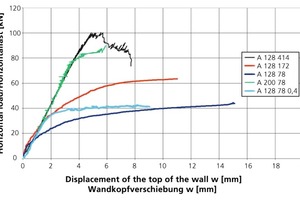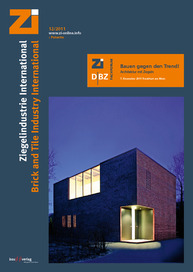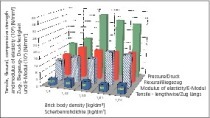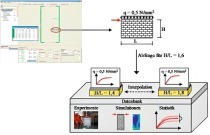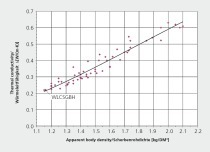1 Background
Objective of the research project was the more precise description of the load-bearing behaviour of masonry built with vertically perforated clay bricks under shear load. Basis for this was the determination of material laws, especially for the description of the fracture behaviour of the building materials, which were determined in tests on small specimens. Under application of these material laws, the shear loading behaviour was analysed in numerical simulations and comparative shear tests.
2 Problem description
The load-bearing capacity of clay brick masonry exposed to shear loading is crucially influenced by the strength properties of the masonry bricks under tensile and compressive load. The design methods currently anchored in German and European regulations are inadequate in their reflection of the actual shear loading behaviour of masonry. Basis for the more precise description of the shear loading behaviour, especially of the fracture behaviour, is the determination of the material laws of the masonry bricks under tensile and compressive stress as well as of the joints between the masonry bricks and the thin-bed mortar under tensile and shear stress.
3 Procedure
In the scope of this research work, empirical and theoretical studies were conducted, which in future are to enable more accurate calculation of shear strength while avoiding cost-intensive element tests and to form the basis for the derivation of analytical calculation methods. In some cases the material laws were derived direct from the empirical studies, in some cases an inverse determination was performed based on numerical simulation of the tests conducted. A vertically perforated brick optimized for shear-loaded masonry in the scope of the European research project ESECMaSE with continuous longitudinal web elements (vertically perforated brick A) and a commercially available masonry brick (vertically perforated brick B) with staggered web arrangement were chosen. They were combined with a thin-bed mortar matched to the masonry brick properties.
4 Results
The empirical studies on shear loading capacity showed no significant influence of the perforation pattern. Masonry built with type B bricks with a higher tensile strength in the longitudinal direction of the brick showed a somewhat higher shear loading capacity in all normal force geometry conditions. The loadable horizontal forces were in the order of magnitude already known from tests conducted in the scope of the EU research project ESECMaSE.
It could be established that a half-brick overlap ü = 0.5 l in comparison with an overlap of ü = 0.4 h does not influence the level of the maximum loadable horizontal load.
The ten shear tests on storey-high walls were simulated with an FE model of the wall element. The anisotropy and heterogeneity of the bricks makes the computational description of the shear failure of wall elements more difficult compared to that of homogeneous and isotropic materials. The model used could not be acceptably validated on the basis of the comparison with the available test results.
This project of the Research Alliance of the Clay Brick and Tile Industry Regd (FGZ) was funded under the project number AiF 15211 N by the BMWi through the German Federation of Industrial Research Associations “Otto von Guericke” Regd. (AiF). It was realized by the Brick Research Institute Essen Regd (IZF). The final report is 101 pages long and available for a handling fee from the Research Alliance of the Clay Brick and Tile Industry Regd in Berlin.

